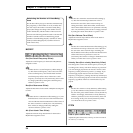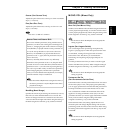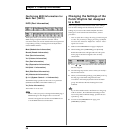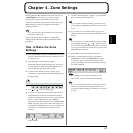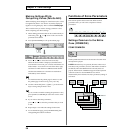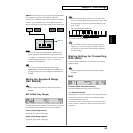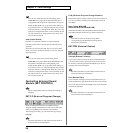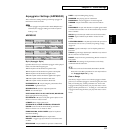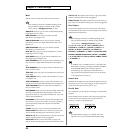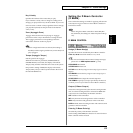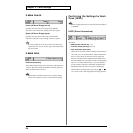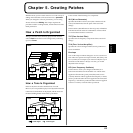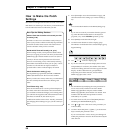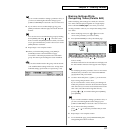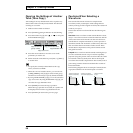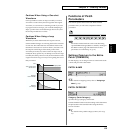
62
Chapter 4. Zone Settings
Motif
Sets the order in which notes of the chord will sound.
Some settings will not be available depending on the
Style parameter setting. For details on the possible
values, refer to “Arpeggio Style List” (p. 268).
SINGLE UP: Notes you press will be sounded individually,
beginning from low to high.
SINGLE DOWN: Notes you press will be sounded
individually, from high to low.
SINGLE UP&DOWN: Notes you press will be sounded
individually, from low to high, and then back down from
high to low.
SINGLE RANDOM: Notes you press will be sounded
individually, in random order.
DUAL UP: Notes you press will be sounded two at a time,
beginning from low to high.
DUAL DOWN: Notes you press will be sounded two at a
time, beginning from high to low.
DUAL UP&DOWN: Notes you press will be sounded two at a
time, from low to high, and then back down from high to
low.
DUAL RANDOM: Notes you press will be sounded two at a
time, in random order.
TRIPLE UP: Notes you press will sound three at a time, from
low to high.
TRIPLE DOWN: Notes you press will sound three at a time,
from high to low.
TRIPLE UP&DOWN: Notes you press will sound three at a
time, from low to high and then back down from high to low.
TRIPLE RANDOM: Notes you press will sound three at a
time, in random order.
NOTE ORDER: Notes you press will be sounded in the order
in which you pressed them. By pressing the notes in the
appropriate order you can produce melody lines. Up to 128
notes will be remembered.
GLISSANDO: Each chromatic step between the highest and
lowest notes you press will sound in succession, repeating
upward and downward. Press only the lowest and the
highest notes.
CHORD: All notes you press will sound simultaneously.
BASS+CHORD 1–5: The lowest of the notes you play will
sound, and the remaining notes will sound as a chord.
BASS+UP 1–8: The lowest of the notes you play will sound,
and the remaining notes will be arpeggiated.
BASS+RND 1–3: The lowest of the notes you play will
sound, and the remaining notes will sound in random order.
TOP+UP 1–6: The highest of the notes you play will sound,
and the remaining notes will be arpeggiated.
BASS+UP+TOP: The highest and the lowest of the notes you
play will sound, and the remaining notes will be arpeggiated.
Beat Pattern
Select the beat pattern from the choices below. This setting
will affect the location of the accent and length of the notes to
determine the beat (rhythm).
Some settings will not be available depending on the
Style parameter setting. For details on the possible
values, refer to “Arpeggio Style List” (p. 268).
1/4, 1/6, 1/8, 1/12, 1/16 1–3, 1/32 1–3, PORTA-A 01–11,
PORTA-B 01–15, SEQ-A 1–7, SEQ-B 1–5, SEQ-C 1, 2,
SEQ-D 1–8, ECHO 1–3, MUTE 01–16, STRUM 1–8,
REGGAE 1, 2, REFRAIN 1, 2, PERC 1–4, WALKBS, HARP,
BOUND, RANDOM, BOSSA NOVA, SALSA 1–4, MAMBO
1–2, CLAVE, REV CLA, GUILO, AGOGO, SAMBA, TANGO
1–4, HOUSE 1, 2
If “PORTA-A 01–11, PORTA-B 01–15” is selected as the
Beat Pattern, the Time parameter (PATCH/CONTROL/
PATCH PORTAMNT) will control the speed of
portamento (p. 76). Adjust the portamento time as
appropriate for the playback tempo. (It is not necessary
to turn portamento switch on.)
Accent Rate
Modifies the strength of accents and the length of the notes to
adjust the “groove” feel of the arpeggio. A 100% setting will
result in the most pronounced “groove” feel.
Shuffle Rate
This setting lets you modify the note timing to create shuffle
rhythms.
With a setting of 50%, the notes will sound at equal spacing.
As this value is increased, the notes will become more
“bouncy,” as if they were dotted notes.
fig.04-15
If the Beat Pattern setting is 1/4, shuffle will not be
applied even if you increase the Shuffle Rate setting.
90 10 90 10
50 50 50 50
Shuffle Rate = 50%
Shuffle Rate = 90%



